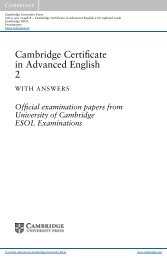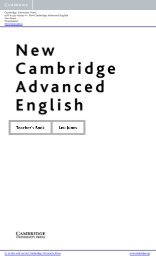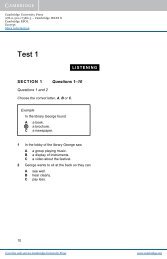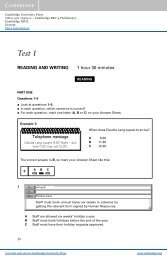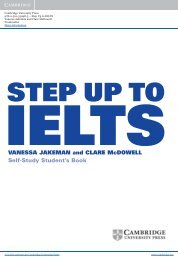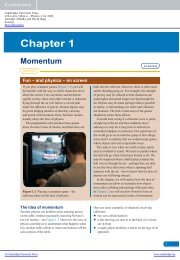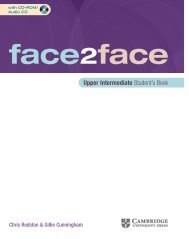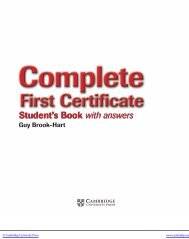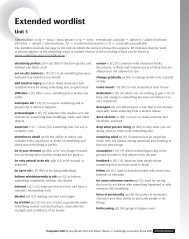Skills for Study Level 2 Teacher's Book - Cambridge University Press
Skills for Study Level 2 Teacher's Book - Cambridge University Press
Skills for Study Level 2 Teacher's Book - Cambridge University Press
You also want an ePaper? Increase the reach of your titles
YUMPU automatically turns print PDFs into web optimized ePapers that Google loves.
* The methods section is not a list or recipe <strong>for</strong> the experiment, but rather adescription of the procedure that was used – hence its being written in the past tense– and so a list here would not be appropriate.+ The methods section does not need to give detailed explanations of all equipmentused, as some of it is so common that it can be taken <strong>for</strong> granted, e.g. you would notwrite ‘cloth to wipe up spilled water’, as this is evidently necessary.3c Students compare their answers.3dSuggested answersAn example of a more concise section is given below. Some of the unnecessaryin<strong>for</strong>mation in this section is:Writing the purpose of each piece of equipment in the materials listDescriptions of the materials unless necessary <strong>for</strong> the experiment (e.g. ‘small,thin pieces of Blu-Tack’ might be considered unnecessary)In<strong>for</strong>mation which is obvious (e.g. the results were recorded ‘in the logbook’ – itstands to reason that they would be recorded in the logbook)Names of participants (e.g. ‘It was recorded by my partner William.’)Obvious actions which are not directly relevant to the experiment (e.g. ‘spiltwater was mopped up with a cloth.’).Example of the rewritten section:Materials and MethodsMaterialsHeader tankControl valveTwo metal pipes of different length and diameter (0.6m long by 9.9mm diameterand 2.58m by 3.85mm)Three tall, transparent plastic tanksBlu-TackLarge glass beakerLarge glass measuring cylinderTape measureStopwatchMethodThe length and diameter of the two pipe sections were measured and recorded.Small, thin pieces of Blu-Tack were stuck onto each vertical tube to show thelevel of the water when the flow rate was zero.The header tank was filled with water and the control valve was opened to allowwater to flow.The control valve was adjusted so that there was a gentle flow of water into thefinal tank. The water levels in the vertical tubes were observed until they settled.Water from the overflow was collected in a large beaker <strong>for</strong> 1 minute.The water was poured into a large measuring cylinder and the flow rate in cm 3was recorded.The measurement was repeated three times to ensure a reliable and consistentflow rate.The height of the water above the Blu-Tack marks was measured.The measurements were repeated in the same way to obtain data <strong>for</strong> fivedifferent flow rates.3e Students compare their answers.3f Student discussionUnit 2 Part E ∙ Reporting in writing 65



